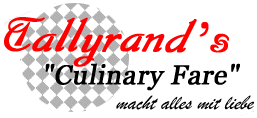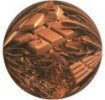

|
CULINARY INFO
|
"DISCLAIMER"
|
"All of the evil that people have thrust upon chocolate is really more deserved by milk chocolate, which is essentially contaminated. The closer you get to a pure chocolate liquor
(the chocolate essence ground from roasted cacao beans) the purer it is, the more satisfying it is, the safer it is, and the healthier it is."
Arnold Ismach, The Darker Side of Chocolate
WHAT IS COCOA?
Firstly lets look at the plant itself, which is called; Cacao, Theobroma cacao, is a tropical evergreen tree in the family Byttneriaceae. It is native to Central and South America and is cultivated extensively for its seed, which is the source of COCOA, CHOCOLATE, and cocoa butter. Cacao is a wide-branched evergreen that grows up to 7.5 m (25 ft) tall and bears seedpods up to 30 cm (1 ft) long and 10 cm (4 in) thick, with a hard leathery shell. Pods contain as many as 40 seeds, or beans, some up to 2.5 cm (1 in) wide.
Several species of Theobroma are cultivated in tropical America. The principal species used for cocoa, is grown throughout the wet, lowland tropics, especially in south-east Asia, South America, and West Africa, where the trees are planted under the shade of taller trees. They usually bear fruit 4 years after they have been planted. Workers harvest cacao beans with knives. After extraction from the fruit, the beans are placed in piles, covered with banana leaves, and allowed to ferment; afterward they are dried to prevent moulding. They are then sacked and shipped to chocolate or cocoa manufacturers. Cacao beans were once used as money by the people of Mexico and Central America.
There are three broad types of cocao plant: FORASTERO and CRILLO plus TRINITARIO which is a hybrid of Forastero and Crillo. Within these types are several varieties.
FORASTERO, which now forms the greater part of all cocoa grown, is hardy and vigorous producing beans with the strongest flavour. AMELONADO is the Forastero variety most widely grown in West Africa and Brazil. It has a smooth yellow pod with 30 or more pale to deep purple beans.
CRILLO with its mild or weak chocolate flavour is grown in Indonesia, Central and South America. Crillo trees are not as hardy and they produce softer pods which are red in colour, containing 20-30 white, ivory or very pale purple beans.
TRINITARIO plants are not found in the wild as they are cultivated hybrids of the other two types. Trinitario cocoa trees are grown mainly in the Caribbean area but also in Cameroon and Papua New Guinea. The mostly hard pods are variable in colour and they contain 30 or more beans of variable colour but white beans are rare.
What is cocoa?
Cocoa is finely pulverised de-fatted, roasted CACAO kernels, to which natural and artificial spices and flavours may be added. It is commercially manufactured by pumping hot CHOCOLATE liquor (semi-liquid ground cacao kernels) into hydraulic cage presses where, under extreme pressure, part of the fat, or cocoa butter, is removed. The fat content of cocoa varies from less than 10% to 22% or more for breakfast or high fat cocoa. Cocoa may be Dutch-processed by mild alkali treatment to change and darken colour and improve flavour. Cocoa is the flavouring ingredient in many confections, baked goods, ice creams, puddings, and beverages. It is also used to flavour some tobaccos and pharmaceuticals.
Chocolate production
Workers cut the fruit of the cacao tree, or pods open and scoop out the beans. These beans are allowed to ferment and then dry. Then they are cleaned, roasted and hulled. Once the shells have been removed they are called nibs. Nibs are blended much like coffee beans, to produce different colours and flavours. The manufacture of chocolate begins with a thorough cleaning of the beans.
Beans are blended to achieve delicate nuances of flavour and then roasted. When cooled, the cacao beans are broken and winnowed by separating the nib from the shell in an air current. The waste shell is totally removed. The clean, cool cacao nib is ground under rotating stones, discs, or rollers. The resulting chocolate liquor, more than 50 percent fat (cocoa butter) and is liquid above 32 deg C (90 deg F).

With a proper mix of chocolate liquor, sugar, cocoa butter and milk solids (for milk chocolate) the production of chocolate begins. These ingredients, automatically weighed and conveyed to large mixers with S-shaped blades are thoroughly blended and then conveyed to large five-roll refiners. These heavy machines with rollers from 100 to 150 cm long and 30-40 cm in diameter, crush the mixture four times. The particles are reduced to microscopic fineness to produce the smoothness typical of eating chocolate.

With a proper mix of chocolate liquor, sugar, cocoa butter, and milk solids (for milk chocolate), the production of chocolate begins. These ingredients, automatically weighed and conveyed to large mixers with S-shaped blades, are thoroughly blended and then conveyed to large five-roll refiners.
These heavy machines, with rollers from 100 to 150 cm (40 to 60 in) long and 30 to 40 cm (12 to 16 in) in diameter, crush the mixture four times. The particles are reduced to microscopic fineness to produce the smoothness typical of fine eating chocolate.
The chocolate is now ‘conched’, a unique process that completely mixes the chocolate at high temperatures; 54 - 71C (130 – 160ºF) while exposing it to a blast of fresh air. During conching, complex chemical changes take place that further develop the chocolate's delicate flavour.
The addition of vanilla or other natural or artificial flavors provides a final flavor note. Lecithin, an emulsifier derived from the soybean, is also added; this establishes the precise viscosity necessary for proper flow in molding or coating. From there different varieties of chocolate are produced.
The chocolate is now ready for use in molded bars, hollow molded bunnies or Easter eggs, or as the coating around a candy. Whatever the product, chocolate is probably the world's favorite flavour and truly deserves the designation Theobroma cacao, given it by the Swedish botanist Carolus Linnaeus in 1728, when he classified the cacao plant as the "food of the gods.
.

WHAT KINDS OF CHOCOLATE ARE THERE?
Firstly one needs to understand the questions how is ‘chocolate made ‘ and ‘what is chocolate’. It is made from the cocao bean, that is dried, roasted and ground. The grinding produces cocoa liquor, from this two distinct items are extracted:
A fat that is called ‘cocoa butter’
A solid that is called 'cocoa mass' and what is refined to make cocoa powder
Depending on what is then added to the cocoa mass the different varieties of chocolate are produced. Each has a different chemical make-up, the differences are not solely in the taste. Be sure, therefore, to use the kind the recipe calls for, as different varieties will react differently to heat and moisture
.
Cocoa
Chocolate liquor with much of the cocoa butter removed, creating a fine powder.
Alkalised cocoa powder, (also known as Dutch processed cocoa), has been treated with an alkali during processing to produce a more mellow, less harsh-tasting, but darkly coloured cocoa.
It can pick up moisture and odours from other products, so store in a cool, dry place, in an airtight container. Depending on its production it may or may not have other ingredients added; sugar etc.
Unsweetened Chocolate
Simply the cooled and hardened version of chocolate liquor. It is used primarily as an ingredient in recipes as by itself it does not taste very nice.
Bitter /dark/plain chocolate
Cocoa mass, cocoa butter and sugar. Normally contains approx. 35% cocoa liquor
Semi-sweet chocolate
It has approx. 15% chocolate liquor, with extra cocoa butter and sugar added. Sweet cooking chocolate is basically the same with more sugar for taste
Milk chocolate
Cocoa mass, cocoa butter, milk or milk powder and sugar and vanilla added. Normally contains approx. 15 % cocoa liquor
White chocolate
In reality (and in many countries; legally) not really chocolate at all, as it contains no cocoa solids, which leaves it the smooth ivory or beige colour. White chocolate is primarily cocoa butter, sugar, milk and vanilla.
White ‘chocolate’ is the most fragile form of all the chocolates; pay close attention to it while heating or melting it. It must be achieved slowly or it will burn and seize very easily.
Couverture
Couverture is a special kind of ‘cooking’ chocolate used by professional chefs. A couverture is simply a chocolate with a relatively higher cocoa butter content (a minimum of 32%, often as much as 39%). This high cocoa butter content contributes fluidity, smoothness, strength and ease of handling. In most cases, these chocolates' also contains a high cocoa solid content which heightens the flavour
The formula on couverture packaging may look like this: 70/30/38. This means that there is 70% cocoa solids, 30% sugar, and 38% total fat content.
**70/30/38 : describes and extra bitter couverture and indicates 70 percent cocoa solids and only 30 percent sugar
**60/40/38 : describes a bitter couverture, which is the most frequently used
**50/50/38 : describes ‘semisweet'
**36/42/38 : describes milk chocolate couverture
These are then classified as either tempered and un-tempered.
Decorator's chocolate or confectioner's chocolate
Isn't really chocolate at all, but a sort of chocolate flavoured candy used for things such as covering strawberries. It was created to melt easily and harden quickly, but it isn't really chocolate. If you want quick and easy, use decorator's chocolate……..if you want the real thing, use real chocolate and patience.
COMMONLY ASKED QUESTIONS
What is that white powdery stuff on my chocolate bar?
This white, filmy residue on chocolate is called a bloom. It occurs when some of the cocoa butter in the chocolate separates from the cocoa solids, usually occuring when the chocolate has been chilled and then stored in a warm area. It is still perfectly safe to eat, but may taste slighlty different.
Can I freeze chocolate?
Freezing chocolate isn't such a great idea. When you freeze it, then thaw it out, it will have a greater tendency to bloom. Chocolate is best kept at room temperature: 20C or 70 degrees Fahrenheit, the temperature of a nice pantry or dark cabinet. Kept at this temperature, chocolate (assuming it isn't covering fruit or other perishables) has a shelf life of about a year.
